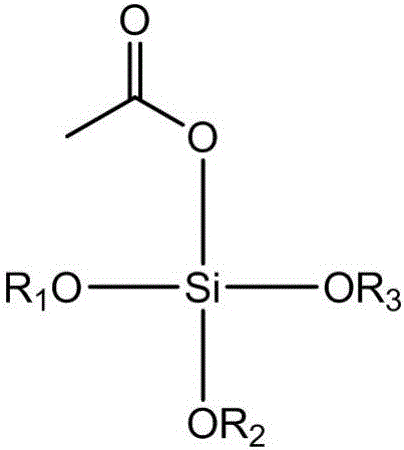Ethylene polymerization Ziegler-Natta catalyst electron donor, catalyst component, and catalyst
A technology of electron donor and catalyst, which is applied in the field of ethylene polymerization Ziegler-Natta catalyst electron donor, which can solve the problems of high price and limited application, and achieve the effects of low production cost, less fine powder of polymerization products, and good particle size distribution
- Summary
- Abstract
- Description
- Claims
- Application Information
AI Technical Summary
Problems solved by technology
Method used
Image
Examples
Embodiment 1
[0034] Put 4.76 g (50 mmol) of anhydrous MgCl 2 , 75 milliliters of decane and 16.3 grams (125 mmol) of isooctyl alcohol were heated to 125° C., and reacted at a constant temperature for 3 hours to obtain a homogeneous and transparent solution. To this solution, 15 mmol of acetoxytrimethoxysilane was added and stirred at 50° C. for 2 hours to dissolve acetoxytrimethoxysilane in the solution. The homogeneous solution obtained above was cooled to room temperature, and then added dropwise to 150 mL of TiCl with stirring at -10 °C within 1 hour. 4 middle. After dropping, the temperature of the mixture was maintained at -10°C for 1 hour, then the temperature was raised to 120°C at a certain rate of temperature increase under stirring, and the temperature was maintained for 2 hours. After 2 hours of reaction, the resulting solid was separated by hot filtration. The solid catalyst is fully washed with decane and hexane respectively until no precipitated titanium can be detected in...
Embodiment 2
[0038] Put 4.76 g (50 mmol) of anhydrous MgCl 2 , 75 milliliters of decane and 16.3 grams (125 mmol) of isooctyl alcohol were heated to 125° C., and reacted at a constant temperature for 3 hours to obtain a homogeneous solution. To this solution was added 15 mmol of acetoxytriethoxysilane and stirred at 50° C. for 2 hours to dissolve acetoxytriethoxysilane in the solution. All homogeneous solutions obtained above were cooled to room temperature, and then added dropwise to 200 mL of TiCl with stirring at -15 °C within 1 hour 4 middle. After completion of the dropwise addition, the temperature of the mixture was maintained at -15°C for 1 hour, then raised to 120°C over 4 hours with stirring, and maintained at this temperature for 2 hours. After 2 hours of reaction, the resulting solid was separated by hot filtration. The solid catalyst is fully washed with decane and hexane respectively until no precipitated titanium compound can be detected in the cleaning liquid, and a soli...
Embodiment 3
[0042] 4.76 g (50 mmol) of anhydrous magnesium chloride, 75 ml of decane and 16.3 g (125 mmol) of isooctyl alcohol were heated to 125° C. and reacted at constant temperature for 3 hours to obtain a homogeneous solution. To this solution was added 15 mmol of acetoxytripropoxysilane and stirred at 50° C. for 2 hours to dissolve acetoxytripropoxysilane in the solution. All the homogeneous solutions obtained above were cooled to room temperature, and then added dropwise to 150 mL of TiCl with stirring at 0 °C within 1 hour 4 middle. After completion of the dropwise addition, the temperature of the mixture was maintained at 0°C for 1 hour, then raised to 120°C over 2 hours with stirring, and maintained at this temperature for 2 hours. After 2 hours of reaction, the resulting solid was separated by hot filtration. The solid catalyst is fully washed with decane and hexane respectively until no precipitated titanium compound can be detected in the cleaning liquid, and a solid titani...
PUM
 Login to View More
Login to View More Abstract
Description
Claims
Application Information
 Login to View More
Login to View More - R&D
- Intellectual Property
- Life Sciences
- Materials
- Tech Scout
- Unparalleled Data Quality
- Higher Quality Content
- 60% Fewer Hallucinations
Browse by: Latest US Patents, China's latest patents, Technical Efficacy Thesaurus, Application Domain, Technology Topic, Popular Technical Reports.
© 2025 PatSnap. All rights reserved.Legal|Privacy policy|Modern Slavery Act Transparency Statement|Sitemap|About US| Contact US: help@patsnap.com



